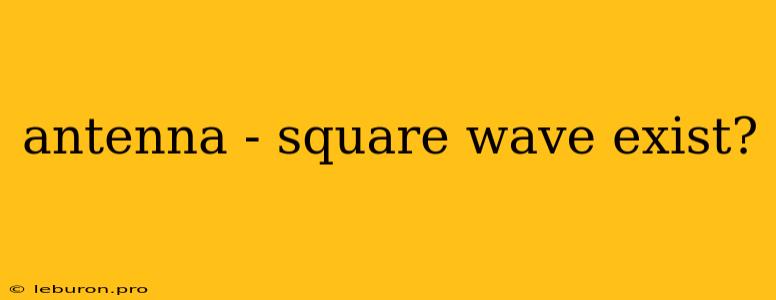The world of electronics is filled with intriguing concepts, and one that often sparks curiosity is the existence of square waves in antennas. While square waves are commonly encountered in digital circuits and signal processing, the question of whether they can truly exist in antennas requires a deeper understanding of the physics involved. This article delves into the nuances of antennas, square waves, and the challenges of transmitting and receiving square wave signals in wireless communication.
Understanding Antennas and Square Waves
An antenna is a crucial component in any wireless communication system. It acts as a transducer, converting electrical signals into electromagnetic waves that propagate through space and vice versa. The primary function of an antenna is to efficiently radiate and receive these electromagnetic waves.
Square waves, on the other hand, are characterized by sharp transitions between high and low voltage levels, creating a distinctive rectangular waveform. While they are ubiquitous in digital electronics, transmitting and receiving square waves in the context of antennas poses unique challenges.
The Challenge of Square Waves in Antennas
The fundamental limitation lies in the nature of electromagnetic radiation. Antennas are designed to radiate and receive sinusoidal waves, also known as sine waves. These waves exhibit a smooth, periodic variation in their amplitude over time. In contrast, square waves, with their abrupt changes, are inherently non-sinusoidal.
Fourier Analysis: Decomposing Square Waves
To understand the challenge further, we can utilize the concept of Fourier analysis. This mathematical technique allows us to decompose any periodic signal, including a square wave, into a sum of sinusoidal waves with different frequencies and amplitudes. In essence, a square wave can be considered as a combination of an infinite number of sine waves.
Implications for Antenna Operation
The implications for antenna operation are significant. When attempting to transmit a square wave using an antenna, the antenna will radiate not just the fundamental frequency of the square wave but also its harmonics, which are multiples of the fundamental frequency. These harmonics can cause interference with other wireless systems operating in the same frequency range, leading to signal degradation.
Bandwidth Considerations
Another critical aspect is bandwidth. Square waves have an infinite bandwidth because they contain an infinite number of harmonics. Antennas are designed to operate within a specific bandwidth, meaning they can only effectively radiate and receive signals within a certain frequency range. Transmitting a square wave would require an antenna with an extremely wide bandwidth, which is impractical and often impossible to achieve.
Approximating Square Waves with Antennas
While transmitting pure square waves through antennas is a significant challenge, it is possible to approximate them using various techniques. These methods involve carefully shaping the signal and employing appropriate antenna designs.
Pulse Shaping
Pulse shaping techniques focus on modifying the edges of the square wave, making the transitions smoother and reducing the generation of high-frequency harmonics. This results in a signal that more closely resembles a sinusoidal waveform, improving the antenna's ability to transmit and receive.
Wideband Antennas
Using wideband antennas, which can operate over a broader frequency range, can accommodate the harmonics generated by the square wave. This helps reduce interference with other wireless systems. However, the bandwidth of even wideband antennas is still limited, so achieving a truly faithful representation of a square wave remains a challenge.
Digital Modulation Techniques
Digital modulation techniques, such as pulse amplitude modulation (PAM) or pulse width modulation (PWM), can effectively represent square waves using sinusoidal carrier waves. These methods essentially encode the square wave information onto a carrier wave, allowing the antenna to transmit and receive the signal.
Applications and Limitations of Square Waves in Antennas
Despite the limitations discussed, there are specific applications where square waves find use in antenna systems.
Pulse Radar Systems
Pulse radar systems utilize short pulses of electromagnetic energy to detect objects. These pulses can be approximated as square waves, and the high-frequency harmonics generated by the square wave can be used to determine the distance to the target.
UWB Communication Systems
Ultra-wideband (UWB) communication systems operate over a wide frequency range and often employ square wave-like pulses for data transmission. The wide bandwidth of UWB systems allows for the transmission of these pulses with minimal distortion.
Limitations
However, it's essential to note that using square waves in antenna systems is not without limitations:
- Efficiency: The generation of harmonics can reduce the overall efficiency of the antenna, meaning more energy is wasted in the transmission process.
- Interference: The harmonics can cause interference with other wireless systems operating in the same frequency range, leading to signal degradation.
- Complexity: Implementing techniques to approximate square waves, such as pulse shaping and wideband antennas, can increase the complexity and cost of the system.
Conclusion
While square waves are a staple in digital electronics, their existence in antennas is a topic of ongoing research and discussion. While pure square waves cannot be efficiently transmitted and received by conventional antennas due to the inherent nature of electromagnetic radiation, various techniques exist to approximate them. These methods, involving pulse shaping, wideband antennas, and digital modulation, allow for the use of square wave-like signals in specific applications such as pulse radar systems and UWB communication systems. However, limitations such as reduced efficiency, potential interference, and increased complexity should be carefully considered when designing and deploying such systems. The field of antenna technology continues to evolve, and future advancements may lead to more efficient and effective ways to utilize square wave signals in wireless communication.
